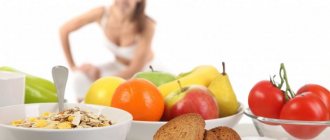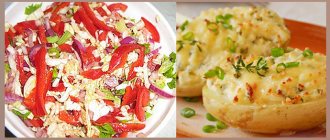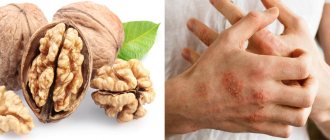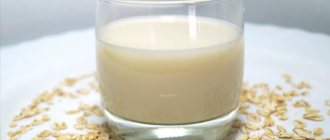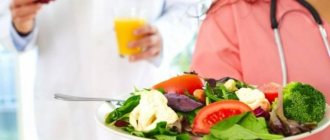Authorized Products
Proper nutrition for duodenal ulcers involves including fast-digesting foods in the diet. There is a false idea that with such a disease you can only eat porridge with water. On the contrary, the diet should be balanced, allowing you to get enough proteins, fats and carbohydrates. Permitted products include:
| Type of products | List |
| Animal origin | Low-fat dairy products (milk, sour cream, cream, low-fat cottage cheese, cheese); meat rich in proteins, including lean fish (turkey, chicken, veal, lean beef); eggs. |
| Fruits and vegetables | Carrots and potatoes; cauliflower; non-acidic fruits and vegetables. |
| Other products | Pasta (boiled only); cereals (semolina, wheat, oatmeal, rice); dried bread; jelly, berry mousses, jelly; marmalade, marshmallows, jam; honey; butter and vegetable oil, including flaxseed and olive oil; low-fat broths. |
List of recommended products
The composition of the “Table No. 1” menu usually prescribes the consumption of the following products:
dried or yesterday's bread made from premium flour;- vegetable broths, soups made from lean fillet, well-cooked cereals, slimy soups or puree soups from cereals or vegetables, it is permissible to eat milk soups;
- as a dressing for soups, you can use a mixture of eggs and milk, small pieces of butter;
- olive or linseed oil;
- boiled or steamed steaks from lean fillet of beef, chicken, turkey, red and white fish, low-fat pork parts;
- You can also make boiled steamed cutlets and meatballs from meat; it is permissible to mix unsalted minced meat without spices with various well-cooked cereals;
- boiled offal and various dishes made from them, for example: soft puddings or cutlets. Among those allowed: liver, tongue;
- rolled oats porridge with water or a mixture of water and milk, buckwheat, semolina.
notePorridges should be very thoroughly pureed, to a semi-viscous consistency;
- boiled and mashed vegetables: potatoes, cauliflower, carrots, beets. Gradually, dishes can be complicated and vegetables can be prepared into stews or puddings;
- dairy products with low fat content and acidity, without dyes and preservatives;
- boiled eggs and various soft dishes made from them, for example: omelet;
- berries (necessarily ripened, without acid) and fruits are added to the menu gradually, only after transition from the acute stage. It is acceptable to eat bananas, apples, pears;
- various types of herbal infusions and teas from medicinal herbs (chamomile decoction, mint, rose hips, special mixtures for the treatment of acute and chronic ulcerative pathologies of the stomach and duodenum;
- viscous oatmeal jelly or from non-acidic fruits and berries;
- when the symptoms of the disease weaken, it is permissible to add small amounts of honey, marshmallows, marshmallows or low-sugar marmalade to the menu;
- healing mineral waters (Essentuki, Borjomi).
Proper nutrition for peptic ulcers of the gastrointestinal system includes not only compliance with the standards of preparation and consumption, but also a correctly composed menu.
Important
In order for the diet to be beneficial, you need to take into account the stage in which the disease is located, the severity of the course and other individual characteristics. That is why it is best to entrust the preparation of a diet according to the “Table No. 1” nutrition list to a gastroenterologist.
In the acute stage of the disease, only viscous porridges made from a mixture of water and 1% milk, and slimy jelly without added sugar are allowed for consumption. You need to drink plenty of fluids and be sure to take medications prescribed by your doctor to relieve acute symptoms.
After the disease begins to subside with the help of gentle nutrition, other foods are gradually introduced into the daily diet, carefully, one at a time. If, after adding any new dish, your health condition worsens, this component must be immediately excluded from the menu and again switched to a more gentle composition of products.
Despite the fact that the transition from normal everyday eating to a diet will seem bleak and tiring, it is important to remember that it is the correct composition of the menu that will help the body recover faster and completely get rid of the inflammatory disease.
Kuznetsova Irina, medical observer
7, total, today
( 194 votes, average: 4.76 out of 5)
Figs: benefits and harm
Are meat and meat products harmful: the official position of WHO
Related Posts
Prohibited Products
Below is a list of products recommended for exclusion at the stage of exacerbation and remission of duodenal ulcers:
- lard;
- fat of animal origin (beef, lamb, pork);
- strong meat broths;
- fresh bread and other baked goods made from yeast dough;
- pickled products;
- smoked meats;
- vegetables and fruits rich in fiber (tomatoes, cucumbers, apples, pears, etc.);
- grilled meat;
- citruses and all hard-skinned fruits;
- sweets;
- fatty dairy products;
- soda, alcohol, strong tea and coffee.
Diet menu for duodenal ulcer
In medicine, therapeutic nutrition for patients with DCP ulcers is called Diet No. 1. It is quite tough, but this is the only way to restore the affected digestive system and maintain it.
Depending on the stage of the disease and severity, the diet menu depends. When a chronic ulcer worsens after surgery, doctors recommend diet No. 1, which includes pureed dishes, liquid porridges and soups with vegetable or weak meat broth, and steamed omelettes.
As soon as the condition improves and severe pain stops, you can move on to menu No. 1b. It's more gentle. The diet includes dishes made from minced chicken and other white meat, grated vegetables, and cottage cheese.
The daily energy value of food should not exceed 3000 kcal, the BZHU ratio is 100/100/420.
Menu options for the day:
Option #1
| Breakfast | Oatmeal with milk/water in a ratio of 1:3. Soft-boiled chicken egg. Tea with milk |
| Lunch | Blueberry soufflé |
| Dinner | Buckwheat soup with vegetables. Steamed turkey cutlets. Stewed cauliflower. Rose hip decoction |
| Afternoon snack | Inconvenient baked goods. Compote |
| Dinner | Semolina porridge with milk in a ratio of 1:3 to water. Pollock baked with zucchini. Weak tea |
| Before bedtime | A glass of milk |
Option No. 2
| Breakfast | Omelette. Boiled rice porridge. Tea with milk |
| Lunch | Banana |
| Dinner | Hercules soup. Steamed chicken meatballs. Pumpkin porridge with butter. Juice |
| Afternoon snack | Fruit jelly |
| Dinner | Boiled fish. Wheat porridge. Cauliflower and carrot puree. Chamomile tea |
| Before bedtime | A glass of milk |
Option #3
| Breakfast | Semolina porridge with milk in a ratio of 1:3 to water. Cottage cheese with yogurt. Coffee with milk |
| Lunch | Banana smoothie |
| Dinner | Soup with rice and vegetables. Steamed beef chops. Carrot and pumpkin puree with butter. Kissel |
| Afternoon snack | Lenten cookies. Dried fruits compote |
| Dinner | Steamed fish cutlets. Mashed green peas with potatoes. Tea with honey |
| Before bedtime | A glass of milk |
Recommended diets
The nutrition of patients with duodenal and gastric ulcers is differentiated depending on the stage of the disease and the severity of the patient’s condition by using several diet options.
Table No. 1
The main one, used in the period of complete and incomplete remission, is diet No. 1, or pureed diet.
It helps to subside inflammation and heal ulcers and erosions on the surface of the mucosa.
It is prescribed during the absence of severe pain symptoms and irritation of the lining of the stomach and intestines.
Diet No. 1 includes products that regulate the secretory and motor-evacuation functions of the gastrointestinal tract, while fully meeting the physiological needs of the body for food ingredients.
Excluded from the diet : foods containing fiber and stimulants of gastric secretion. Exclusively steam and mashed methods are used for preparing all dishes.
The frequency of meals when using diet No. 1 is at least five times a day, in small portions, while the daily calorie content is at least 2500–3000 calories.
Diet food set is presented as:
- wheat bread and yesterday's baked goods, dry cookies and biscuits, savory pies filled with jam, apples, boiled fish, eggs or meat;
- low-fiber vegetables in the form of puree or steamed puddings - potato, beetroot, squash, carrot, pumpkin;
- lean varieties of meat (teltin, young lamb, rabbit, trimmed pork, chicken, chicken, turkey) and mainly river varieties of fish (perch, pike, pike perch, cod) without fascial layers, skin and tendons;
- whole milk, cream, unleavened cottage cheese in the form of casseroles and soufflés, sour cream;
- fresh eggs in the form of steam omelets or soft-boiled;
- sweet and ripe berries and fruits in the form of preserves, jams, marshmallows or marmalade, mashed or baked. Sweet fruit juices (raspberry, strawberry) must be diluted with water in equal parts.
- fats in the form of butter or refined vegetable oils, which are added to dishes in their natural form, without frying.
To obtain a good therapeutic effect, diet No. 1 is used for 6-12 months from the onset of an exacerbation.
Sample menu No. 1 consists of dishes prepared boiled, mashed or baked:
- pureed soups - cereal, vegetable (except cabbage) or dairy, with pureed carrots, beets or mashed potatoes, with the addition of butter, olive and other refined vegetable oils;
- pureed or minced meat and fish cutlets, soufflés or rolls, or boiled in water in whole large pieces;
- mashed milk or semi-vyazka porridges, steam puddings (except wheat), cheese cakes and soufflés, boiled pasta or vermicelli, cutlets from mashed cereals;
- drinks in the form of weak tea with milk or cream, vegetable juices (beetroot and carrot), decoction or compote of rose hips or wheat bran.
- sweets in the form of boiled or baked berries and fruits, purees, milk jelly, mousses, honey and jelly, butter cream, honey, marshmallows and marshmallows.
READ ALSO: Food poisoning: treatment at home and further prevention
To season dishes, you can use milk and fruit sauces, as well as finely chopped parsley or dill.
Table No. 1a
Diet N 1a, or the most gentle diet, is used at the height of exacerbations of the ulcerative process, when the symptoms of irritation of the stomach and intestines are pronounced.
Typically, such a diet is prescribed simultaneously with bed rest.
Diet No. 1a is characterized by a sharper limitation of mechanical and chemical stimuli, in comparison with the previous version.
All dishes are prepared exclusively using steam or pureed methods, the consistency is liquid or semi-liquid. Meals are divided up to 6 times a day with food temperatures ranging from 15 to 65 degrees C.
Completely excluded from the diet:
- all bakery products;
- vegetables in any form;
- any snacks, sauces, seasonings and spices.
Sample menu No. 1a consists of:
- slimy oatmeal, semolina, buckwheat or rice soups;
- steamed fish and meat soufflés - no more than once a day. Lean varieties of meat (veal, rabbit), fish (pike perch, pike, cod, perch) or poultry (turkey, chicken) are used, excluding tendon tissue, skin and fascia;
- liquid pureed porridge in water with milk or cream from cereals, excluding wheat - no more than once per day;
- whole milk, non-acidic milk-containing products, cream, curd mousse or steamed soufflé;
- egg dishes - steam omelettes, soft-boiled eggs (from one to three pieces per day);
- drinks in the form of fruit and berry jelly from sweet varieties, juices diluted with water, rosehip decoction or wheat bran;
- butter - as an additive to ready-made dishes.
Steamed cutlets, zrazy, boiled beef stroganoff, quenelles, meatballs and soufflé are also allowed.
This strict restrictive diet is indicated in the first two weeks after the onset of exacerbation of the ulcerative process.
It is also used in patients in the postoperative period after surgery on the stomach or intestines.
Table No. 1b
It is prescribed at a later period, immediately after completion of the course of treatment using table No. 1a.
The diet differs from the previous one in the ratio of proteins, fats and carbohydrates and higher calorie content.
It also significantly limits the list of mechanical and chemical irritants of the stomach and intestines.
The diet includes bread in the form of white crackers of the highest grade, meat and fish cutlets, meatballs or quenelles.
In addition to pureed soups, pureed porridges are allowed in the diet; the frequency of their consumption is also increased. .
Dishes are also prepared in liquid or porridge form, and you need to eat 5-6 times; vegetables, fruits and bread remain prohibited.
Nutritional recipes for duodenal ulcers
Table No. 1 is predominantly rich in cream soups. During the period of escalation of the crisis, special attention must be paid to the rules for preparing these particular dishes.
| Ingredients | Cooking method |
| First meal | |
| Turkey milk cream soup with croutons | |
| 200 g turkey fillet | Boil the rice until the grains are cooked Boil the turkey until cooked, grind in a blender until it becomes a paste Add the meat to the rice water, add salt, boil for another 5-10 minutes Cool to 80 degrees, add milk and cream and leave on low heat for another 5 minutes, stirring Cool to room temperature, add croutons when serving |
| 100 grams of rice | |
| 50 g croutons | |
| 50 g milk | |
| 50 g cream 10% | |
| Pumpkin and cauliflower soup | |
| 200 g pumpkin | Rinse the vegetables, put them in a saucepan, add water so that it covers the vegetables by 1 cm. Cool, chop with a blender. Mix milk, flour and egg, add to the broth, add salt, put on low heat, stirring constantly until the consistency begins to thicken to a liquid state. porridge |
| 200 g cauliflower | |
| 150 g milk | |
| 1 tsp flour | |
| 1 egg | |
| Second courses | |
| White fish pudding with green peas | |
| 400 g pollock fillet | Boil the fish until tender and grind with a blender. Separate the yolks from the whites. Add butter and yolks to the fish, mix thoroughly. Beat the whites until thick foam. Add the whipped whites to the mixture in portions, stirring gently. Place in a mold and steam. Boil the peas in lightly salted water. |
| 2 eggs | |
| 20 g butter | |
| 300 g peas | |
| Beef soufflé | |
| 300 g beef | Boil the beef until tender and chop with a blender Separate the yolks from the whites Mix the milk with flour, melted butter and yolks Beat the whites until thick foam Add milk sauce to the meat, salt Add the whipped whites to the mixture in portions, stirring gently Place in a mold and steam |
| 100 g milk | |
| 1 tsp flour | |
| 30 g butter | |
| 2 eggs | |
| Dessert | |
| Carrot and pumpkin pudding | |
| 2 large carrots | Chop the carrots and pumpkin, simmer with a little water until tender. Rub the mixture, add milk, semolina, cook over low heat for another 5 minutes, stirring constantly. Cool the mixture. Beat the yolks and whites separately. Carefully add the yolks and whites to the mixture alternately. Place in a mold. and send it to bake. Make sure the crust is not crispy |
| 200 g pumpkin | |
| 100 g semolina | |
| 2 eggs | |
| 100 g milk | |
Main courses for stomach ulcers
When the period of exacerbation has passed, and the clinical manifestations of the disease have disappeared, you can use recipes for second courses. Main courses can be steamed or baked in the oven.
Advice! It is better to bake food and cook dietary dishes in the oven over low heat. This will avoid the formation of a crust, which is harmful for peptic ulcers.
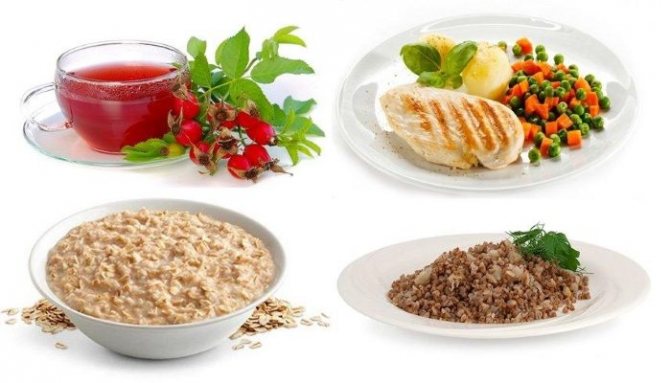
Recipes for stomach ulcers usually consist of lean meat, vegetables, eggs, and dairy products. All products (especially meat) must be purchased from trusted sellers, and not in a store.
Steam cutlets
Steamed cutlets go well with almost any side dish allowed for stomach ulcers. Any lean meat can be used as the main ingredient. For example, veal, rabbit, beef, turkey or chicken. To prepare 1 serving, you will need the following set of products:
- selected type of meat – 100 g;
- wheat (yesterday's) bread - 1 piece;
- olive oil – 1 tsp;
- water or milk – 15 ml;
- salt - a pinch.
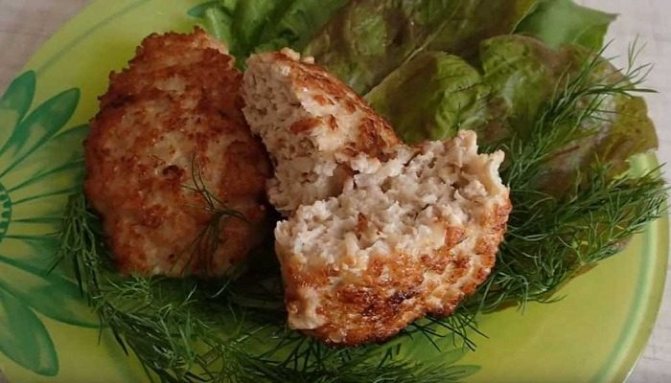
The meat should have a uniform consistency and tender, so it should be minced several times. Olive oil, salt and bread soaked in water are added to the finished minced meat. The cutlets are kept in a water bath for 40 minutes.
Advice! Boiled rice, potato or vegetable puree are suitable as a side dish.
Fish pudding
Products prepared in the form of pudding will be useful for gastrointestinal diseases. For example, meat or vegetable puree. As you know, seafood is rich in vitamins and microelements, which are so necessary during the recovery period after a stomach ulcer.
Therefore, fish should become an integral part of any diet. To prepare fish pudding, you need to take:
- lean fish fillet – 100 g;
- milk – 2 tbsp;
- white bread - 1 piece;
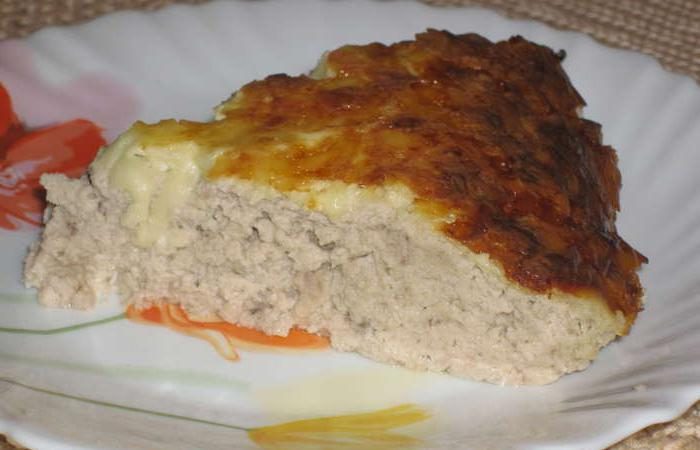
- yolk - 1 pc., white - 2 pcs.;
- butter – 1 tsp;
- salt - to taste.
One part of the fillet is boiled in water, the other is rolled through a meat grinder. Bread soaked in milk is added to the minced fish. Then both parts are mixed, butter and yolk are added. Whisk the whites into a strong foam and then carefully fold them into the fish mass. The resulting mixture is poured into small molds.
Beef soufflé with cottage cheese
Beef soufflé with cottage cheese is another recipe that meets the dietary requirements for stomach ulcers. To prepare the dish you need to take the following products:
- boiled beef fillet – 200 g;
- low-fat cottage cheese – 50 g;
- butter – 10 g;
- yolk – 1 pc., white – 1 pc.
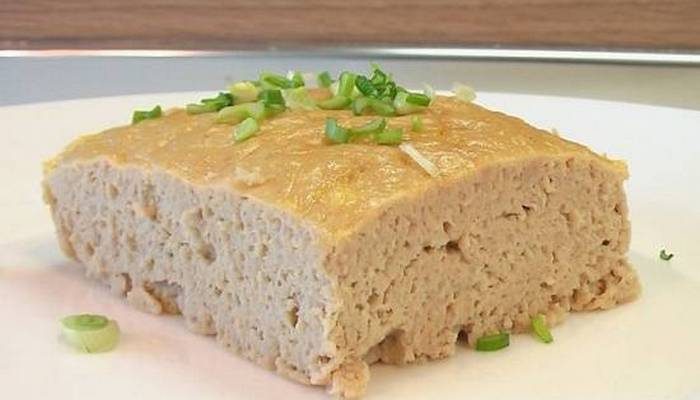
Meat and cottage cheese are passed through a meat grinder several times. Oil and yolk are added to the resulting minced meat. Whipped protein is introduced gradually. The minced meat is formed into small balls, which are then steamed.
Advice! Instead of cottage cheese, you can take any vegetables, for example, potatoes, zucchini, pumpkin, etc. They not only give the dish a unique aroma and taste, but also enrich it with healthy vitamins.
Comments from nutritionists
Therapeutic diet No. 1, developed back in Soviet times by nutritionist M.I. Pevzner, is still relevant today for patients with duodenal ulcers. It is recommended to follow it for at least six months. During this time, the patient will not only get rid of digestive problems, but also get used to proper nutrition.
The main disadvantage of all diets is their monotony. Lenten dishes may soon become boring, and the patient returns to his usual diet. Nutritionists note that the list of allowed foods for duodenal ulcers is wide enough to prepare a variety of dishes every day. Doctors note:
- You should not completely limit yourself in salt. The permissible norm is 5-7 g/day. It is important to remember that some vegetables, fruits and meats already contain salt , so the food will not seem overly bland.
- Drinking regime is the key to the effectiveness of the diet. Tea, decoctions, coffee are drinks. Only drinking water will bring benefits. At the same time, a glass of it 30 minutes before meals is not only acceptable, but also recommended. But after eating you need to abstain for at least an hour.
- Therapeutic diet No. 1, if strictly followed, will give tangible results within 1-2 weeks. During it, overweight people can lose extra pounds.
Therapeutic diets
One of the most important methods of treating stomach ulcers is a diet that is correctly selected at a certain stage of the pathological process.
It is important to consult a doctor in time. An experienced nutritionist or gastroenterologist will prescribe the correct special diet for stomach and duodenal ulcers, a list of foods allowed for consumption, and other important recommendations.
Depending on the degree of damage and the stage of the disease, there are several types of dietary tables.
Each menu contains the necessary dishes, specially selected for a specific situation.
Diet No. 1
This menu is prescribed for chronic peptic ulcer disease during an exacerbation. Sometimes the pathology is accompanied by bleeding.
The diet is also recommended for use during recovery after drug therapy. Follow this diet for 5 months.
Adhere to the following ratio - carbohydrates, proteins, fats (5:1:1). Between each meal take 2-3 hour breaks.
At this stage, patients complain of pain in the stomach, so all food should be gentle.
Based on the presented products, a menu for stomach ulcers is drawn up for a week. What's included in this list:
- lean boiled meat;
- dried bread;
- vegetable oil, butter;
- low-fat cottage cheese, sour cream, milk;
- boiled, stewed, steamed vegetables;
- sea fish, boned and skinned;
- baked apples and pears;
- Drinks include purified water without gas, medicinal mineral water (Essentuki), weakly brewed tea with milk, freshly squeezed juices diluted with water.
Diet for stomach ulcers at this table excludes the consumption of radishes, radishes, legumes, cauliflower, cabbage and Brussels sprouts.
Diet No. 1 – a
This diet provides nutrition for stomach ulcers, provided for in dietary table No. 1.
This type of diet has a more strict version, suitable for patients with exacerbation of a chronic ulcer with bleeding.
With this course of the disease, bed rest is prescribed. Prepare a menu for a week for stomach ulcers in advance, based on permitted foods.
Avoid all foods that can provoke the secretion of gastric juice. Eat small meals, 6-8 times a day.
The daily norm is no more than 2000 kcal. To quickly scar the ulcer, you should switch to light soups, semolina, oatmeal, lean fish, and white meat.
Diet No. 16
After completing the course of treatment using diet No. 1 - a, they move on to the next stage of treatment.
This dietary table differs from the previous one in the large number of calories in the ratio of proteins, fats, carbohydrates.
With this diet, foods with chemical and mechanical irritants that can harm the gastrointestinal tract are not allowed.
The menu includes bread (white crackers made from the highest varieties of wheat), fish and meat cutlets, quenelles, and meatballs.
This includes pureed soups, pureed porridges. Food should be liquid and mushy. The number of meals per day is 5 – 6 times. It is unacceptable to eat fruits, bread, and vegetables.
Diet No. 5
This dietary food is prescribed when all signs and symptoms of the disease are relieved.
When normal functioning of the digestive system resumes, you are allowed to eat:
- dried bread;
- biscuits, oatmeal cookies;
- vegetable soups, borscht;
- hard cheese without spices;
- all fresh juices except pomegranate;
- natural coffee with milk;
- herbal infusions, teas.
It is still contraindicated to eat:
- onion, garlic, ginger;
- fried food;
- dumplings, dumplings;
- fish soup, fatty rich soups, mushrooms;
- soy and hot sauce;
- radish, radish;
- sorrel.
When relieving unpleasant symptoms, you should exclude all heavy foods. Any irritating factor can provoke an exacerbation.
